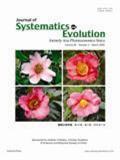Xiao-Hong YU, Yi-Bo LUO, Ming DONG
The genus Cymbidium comprises three subgenera with ca. 50 species. Interactions between pollinators and plants have been studied in the two subgenera Cymbidium and Cyperorchis, but only a few studies in the subgenus Jensoa have been reported. Here we report on the reproductive characteristics of C. goeringii (in sub-genus Jensoa) in three populations in the southwest of Hunan Province, China, during the winter from December 2005 to March 2006. Floral phenological and morphological features, behavior of visitors, the breeding system, and fruit sets under natural conditions were studied. The flowers of C. goeringii were strongly fragrant, but did not present any rewards to the visitors. The flowering period of C. goeringii in the studied populations lasted about 40 days, and most flowers (about 60%) opened within 30 days. Flowers opened immediately when temperature increased obviously and reached to about 16 ℃. The flowering time of the pollinated flowers, unpollinated flow-ers and the flowers with pollinarium removed were similar. Two bees of Apidae, Apis cerana cerana (honeybee) and Anthophora melanognatha, were observed visiting flowers of C. goeringii, but only the honeybees performed as pollinators. The honeybees mostly visited the orchid flowers at 10:00–17:00 on sunny days with temperature above 10 ℃. A total of only thirteen visits were observed during 20 days of observation, indicating pollinators were rare. Honeybees directly landed on the upper surface of the labellum and inserted their heads into the flowers between column and labellum, while the hind legs trod on the surface of the curved downward mid-lobe of label-lum. When a honeybee landed on the labellum of a flower, the labellum moved up and down slightly. After the honeybee entered the flower further, its head might touch the foot of the column. At this time, the body of the honeybee was parallel with the upper surface of the labellum. Then the honeybee used its front legs to scratch on the callus ridges on the upper surface of the labellum, and its hind legs hooked the edges of the side lobe of label-lum, trying to exit forcibly from the flower. During exiting process, sometimes the honeybee’s body was arched owing to tension. In this case, the surface of the scutellum came into close contact with the viscidium and then pollinaria, together with the anther cap, were removed. When this honeybee visited next flower, the pollinaria would be adhered to the stigma when it arched its body during the exiting process. Three plant species flowered synchronously with C. goeringii in the studied areas, but their flowers were different with C. goeringii in color or shape. Because C. goeringii is rewardless to pollinators, the flowers probably attract visitors by olfactory stimu-lus. Breeding system experiments showed no spontaneous autogamy and pollination success relying on pollinators in C. goeringii. Artificial pollination resulted in 90% fruit set by induced autogamy, 100% by pollinating within clone, and 100% by xenogamous pollination, respectively. These results indicate that C. goeringii is highly self-compatible and the fruit production is pollen limited. Because pollinators are essential for fruit set of C. goeringii in natural habitats, protection of wild honeybee populations or apiculture is likely a simple but effective strategy to maintain the orchid populations.

